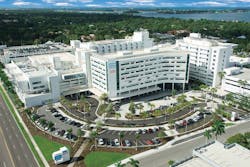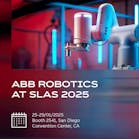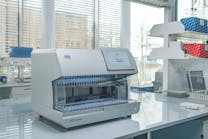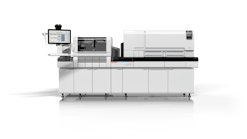Sarasota Memorial Hospital laboratory techs talk automation
Just five miles down the road from the Sarasota, Florida office of MLO/Endeavor Business Media, sits Sarasota Memorial Health Care System (SMHCS), an 839-bed regional medical center. Within its walls are over 5,000 staff, over 900 physicians, and 600 volunteers.
Humble beginnings
In 1921, faced with a growing need for organized healthcare, residents of Sarasota began raising funds to build a hospital. A yearlong fund-raising campaign was conducted, along with a “tent hospital” and a temporary six-bed facility to treat patients and emergency cases. It was said that no businessman dared to venture down Main Street without first pulling his pockets inside out, thereby making a public statement that he had no more money to give for the hospital!
The hospital is the waking reality of “the dream of many made possible by the intensive efforts of a few and the generosity of all,” as the Sarasota Herald Tribune wrote in November 1925 to announce the opening of the first modern hospital, featuring 32 beds, in Sarasota County.
Total Laboratory Automation Solution
Employing a state-of-the-art, total automation system
SMHCS has come a long way since 1925. On Friday, August 3, 2018 (approximately 93 years later), an official ribbon cutting ceremony took place for one of their most tremendous accomplishments to date—a laboratory automation line!
The Sarasota Memorial Hospital (SMH) laboratory became one of the first in the U.S. to process the majority of its patient samples from beginning to end using a new state-of-the–art, total laboratory automation system from Siemens Healthineers. The line employs the Siemens Aptio by Inpeco automation solution, performing chemistry, immunochemistry, coagulation, and hematology analysis. The fully automated process helps improve the timeliness, accuracy, and reliability of test results. As a side note, the SMH lab was designated a Center of Excellence by Siemens Healthcare Diagnostics for Automation and Chemistry in June of 2018.
As per the SMH laboratory director, “The implementation of total laboratory automation is a challenging task since the laboratory cannot stop production at any time. We had to maintain our full function during seasonal volume upswings (a Florida thing), while also completing the installation, testing, and migration to the new equipment and automation line process. Our staff did a phenomenal job adjusting to change and focusing on our patient care mission. Siemens partnered well with us, as did Sysmex for our hematology. It was truly a team sport designed to ultimately benefit patient care in our region of Florida.”
Since 70 percent of all clinical decisions are based on lab results, and because SMH’s lab performs more than 2.6 million tests per year, ensuring prompt, reliable results is the department’s number one priority. Current services include hematology/coagulation, biochemistry (including endocrinology and therapeutic drug monitoring), immunology/serology/urinalysis, microbiology/parasitology,immunohematology/transfusion services, and virology.
Previously, the lab processed tests through multiple inputs using various modalities. The new system allows the laboratory to automate about 80 percent of its testing, including many of its most common tests, freeing up professional staff members to concentrate on the remaining 20 percent of samples, which typically come from acutely ill patients that require additional analysis and expertise.
MLO visits the lab
We had the opportunity to tour the clinical laboratory at SMCHS, thanks to the Director of Laboratory Services, Harold Vore, MS, MT(ASCP), and Laboratory Operations Manager, Dana Rickard, BS, MT(ASCP).
As we were escorted into the lab, we saw laboratorians in white lab coats going about their daily routines—hustling to run tests and keep out of each other’s way with the end goal of getting results to the ordering physicians. And not just from their facility, but many other reference labs that utilize their services.
The automated equipment that wrapped around the entire lab was reminiscent of a conveyer belt found in a manufacturing facility; transporting test tubes and specimen containers from spot to spot. To outsiders, like ourselves, the equipment appeared to make the laboratorians lives a bit easier. However, we wanted to speak to those who had been in the business long enough to see the laboratory landscape evolve and to find out if automated equipment truly did make their job easier. Who better to give us insight, other than those who live it?
Back in the day
Margaret, who has admirably worked in the SMH lab since 1995, shared that “back in the day,” the laboratory was much more compartmentalized, including assigned departments and separate instrumentation, both of which resulted in more specialty technologists.
She reflected that Chemistry techs worked in the main lab every day, however, Microbiology only worked in Microbiology. Hematology had its own techs, as did Coagulation. Each department knew the ins and outs about everything in their particular department.
Even back then equipment was still pretty good, but it certainly wasn’t integrated on a line. Specimens didn’t get loaded to one central location. Techs had to manually load everything. And when things were done, they weren’t multiuse; so they had to be sealed and physically brought to the next area. Things were much more hands-on at that time.
Not to mention, there were no laboratory information systems or electronic health records—so information was documented by hand, several techs mentioning file cards and a file card system.
Today, the lab staff is more united. There are more generalists who work all areas due to advanced technology. Most departments, like Chemistry, Hematology, Urinalysis, and Coagulation are rotated; except Blood Banking and Microbiology. Microbiology doesn’t work out in the “main land” and vice versa.
Although those we spoke with unanimously concluded automation’s impact has made a difference for the better, it was not without its challenges. The pros? Obtaining a patients lab results quicker and more efficiently. The cons? Learning how to fix multiple analyzers.
Troubleshooting instruments
Diane is a technical specialist in Microbiology. She shared that her department has received four new instruments within the last six months—all of which have new technology—and all of which needed validation. Her team is expected to know the machines. And if they need assistance, they’re to solicit a shift super-user for guidance and troubleshooting. Then, if the issue(s) can’t be resolved, a call into the 1-800-service line is in order.
We were told laboratorians not only want more in-house training, they want more training in school. Years of diagnostics training isn’t preparing them for using multiple analyzers and laboratory information systems when they get on the job. Point of care is very IT oriented. Waiting until an internship to experience hands-on training is too late.
Yet, the laboratorians at SMH persevere through these challenges and their learning curve is becoming smaller each day. These skilled professionals are truly dedicated to the laboratory as well as their patients, and take their responsibility to troubleshoot the machines in stride.
Out with the old
Linda was identified to us as a laboratorian who worked her whole career at SMH’s laboratory. She knew we wanted to talk to some “old-timers” and had a great sense of humor. The first thing she said when she entered the interview room was, “I heard you guys want to talk to some old people!”
After the laughter stopped, Linda told us that she had been in the field since 1971. She joked, “I started here young and single, and here I am, an old married grandmother!”
She let us know that she could barely type when they started introducing computers in the laboratory, and that she came from a small town in Indiana. When she was growing up, she said, if you were interested in medicine, “males were doctors and females were nurses.” She didn’t learn about the laboratory being an option until she was in college. She enjoys the hands-on aspect and the chemistry. The rest, you can say is history.
Linda works in Microbiology, which is just getting into automation at the SMH laboratory. She has a very positive outlook on things changing, stating, “I’ve always liked to learn new things.” She hopes the move to automation in Microbiology will help standardize tasks, “I may plate something different than the next guy” she explains.
All the techs we spoke to knew the average age of a laboratorian is 58 and recruiting newcomers is challenging. Lack of education, career path information, public awareness, and soliciting the wrong demographic seems to be contributing to the lack of recruits.
Margaret, who if you recall has been in this industry for almost 25 years, openly confessed that both her family and friends don’t know what a medical laboratory technician is! “I just end up telling people I’m a laboratory scientist,” she said.
We were also told nurses are now being trained to do laboratory testing—taking on more and more testing in addition to what they are already doing—but it’s not ideal. Nurses already carry heavy workloads, and are not trained laboratory specialists.
When we asked Linda if she’d advise her grandchildren to go into the medical laboratory field she said, “We’re going to need more IT staff and engineers. We don’t have to get the biochemicals anymore, that part of it isn’t as integral now, it’s more about running the instruments. Not to say that those things shouldn’t be learned in school but being able to work with the instrument is imperative.”
In with the new
The extraordinary laboratorians we interviewed could take up many more pages of MLO, and truly gave us a lot of thought-provoking material to write this article. One thing we did notice was that each and every tech’s number one goal was getting quality test results to the physician’s patient in the fastest and most efficient way possible; automation or no automation. As new technologies evolve in the workplace, it takes time for the bumps to be smoothed out, and no one was ready to throw in the towel.
Linda said it best at the end of our time with her, “I love the profession. At the end of the day, I can go home and say, ‘you know, this has been accomplished and Joe will live another day because of me.’”
We agree, Linda. Thank you.
Editors’ note: The names of the laboratory technicians have been changed in this story to preserve anonymity.
For more information on automation and how to apply its benefits to your laboratory, read “Leveraging automation as strategy to overcome today’s laboratory challenges” from Siemen’s Healthineers.







